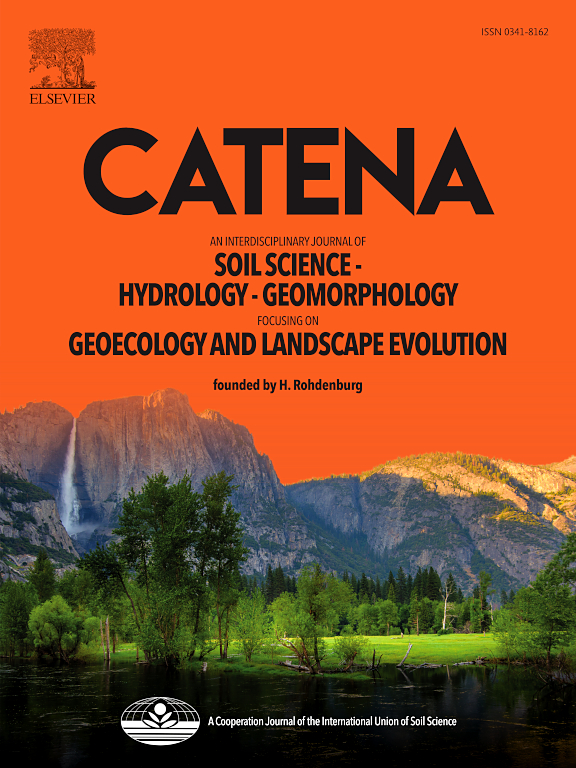黏土矿物、凋落物质量和蚯蚓对土壤有机质储量的影响黏土宏观孔隙度比表面积更重要
IF 5.7
1区 农林科学
Q1 GEOSCIENCES, MULTIDISCIPLINARY
引用次数: 0
摘要
黏土矿物对土壤有机质,尤其是矿物伴生有机质(mineral associated有机质,MAOM)的积累起着重要的作用。然而,人们对粘土矿物如何与凋落物和土壤动物相互作用知之甚少。本研究使用了一系列长达一年的微观世界实验,观察了在蚯蚓存在或不存在的情况下,由高岭石、伊利石和蒙脱石等单独粘土矿物主导的三种土壤形成基质的碳(C)储存轨迹,这些基质由两种碳(C)与氮(N)比不同的树种(桤木和橡树)的凋落物提供。我们检验了MAOM将成为土壤有机质主要来源的假设。我们预计随着黏土矿物(高岭石<;伊利石& lt;蒙脱石),凋落物分解性(橡木<;桤木)和蚯蚓加工。实验表明,尽管蒙脱石的表面积最大,但在矿物层中,伊利石的碳储量最大(平均0.53 g),其次是蒙脱石(0.25 g)和高岭石(0.10 g)。桤木凋落物提供的土壤碳储量也高于栎木凋落物提供的土壤。有蚯蚓的土壤比没有蚯蚓的土壤具有更高的碳储量。土壤中碳的储存主要集中在颗粒有机质中,蒙脱土的孔隙大多为纳米级,不足以容纳颗粒有机质,而伊利石的孔隙以微米级居多。统计发现,碳储量、微生物生物量、呼吸和热水可提取碳之间呈正相关。结果还表明,凋落物中的POM在矿质土壤中是一个重要的转移。在蚯蚓和容易分解的垃圾存在的情况下,这个过程变得更加明显。本文章由计算机程序翻译,如有差异,请以英文原文为准。

The effect of clay minerals, litter quality, and earthworms on soil organic matter storage; clay macro-porosity is more important than surface area
Consensus holds that clay minerals play an important role in accumulation of soil organic matter, especially mineral associated organic matter (MAOM). However, little is known about how clay minerals interact with litter and soil fauna. This study used a series of year long microcosms experiments to observe the carbon (C) storage trajectories of three soil forming substrates dominated by the individual clay minerals of kaolinite, illite, and montmorillonite, supplied by litter from two tree species with contrasting carbon (C) to nitrogen (N) ratios (alder and oak), in the presence or absence of earthworms. We tested the hypothesis that MAOM would become a major source of soil organic matter. We expected storage to increase with increasing surface area of clay minerals (kaolinite < illite < montmorillonite), litter decomposability (oak < alder), and earthworm processing.
Experiment showed that illite provided the greatest C storage in mineral layer (in average 0.53 g microcosms−1) followed by montmorillonite (0.25 g) and kaolinite (0.10 g), despite highest surface area of montmorillonite. C storage also appeared higher in soils supplied by alder litter relative to those supplied by oak litter. Soils with earthworms showed higher C storage relative to those evolving in the absence of earthworms. Most of the C stored in soils resided in the particulate organic matter fraction (POM), most pores of montmorillonite were nm size, too small to accommodate POM, while illite showed the highest proportion of micrometer size pores. Statistics detected a positive correlation between C storage, microbial biomass, respiration, and hot water extractable carbon. Results also showed that incorporation of POM from litter into mineral soil is a crucial transfer. This process becomes more pronounced in the presence of earthworms and easily decomposable litter.
求助全文
通过发布文献求助,成功后即可免费获取论文全文。
去求助
来源期刊

Catena
环境科学-地球科学综合
CiteScore
10.50
自引率
9.70%
发文量
816
审稿时长
54 days
期刊介绍:
Catena publishes papers describing original field and laboratory investigations and reviews on geoecology and landscape evolution with emphasis on interdisciplinary aspects of soil science, hydrology and geomorphology. It aims to disseminate new knowledge and foster better understanding of the physical environment, of evolutionary sequences that have resulted in past and current landscapes, and of the natural processes that are likely to determine the fate of our terrestrial environment.
Papers within any one of the above topics are welcome provided they are of sufficiently wide interest and relevance.
 求助内容:
求助内容: 应助结果提醒方式:
应助结果提醒方式:


